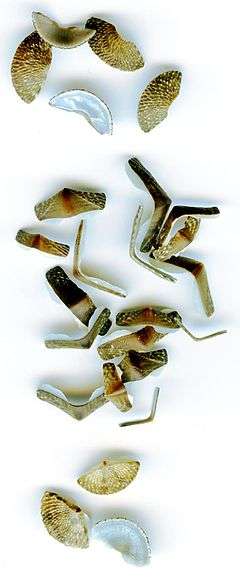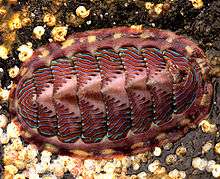Valve (mollusc)

Valve is an anatomical term applied to the shell of those molluscs that have a shell. Although in theory any mollusc shell can be termed a "valve", the word is now most commonly applied to members of two classes of molluscs: the Bivalvia (clams) and the Polyplacophora (chitons), in other words, to those molluscs whose shells are normally composed of more than one articulating part, each one of which is known as a valve (and also, in the case of chitons, as a "plate".)
Species within one family of very unusual small sea snails, marine opisthobranch gastropods in the family Juliidae, also have two articulating shells or valves, which resemble those of a bivalve. This exceptional family is commonly known as the bivalved gastropods. Gastropods in general are sometimes called "univalves", because in those that have a shell, the shell is usually in one part.
Chitons

The valves of chitons are eight dorsal, articulated shell plates, which are frequently coloured and sculpted. After death the girdle that holds the plates together disintegrates and the plates separate. Thus individual plates can be found washed up in beach drift, as shown in the image at the top of this article.
Bivalves

Bivalve molluscs (e.g. clams and oysters) have a shell which is composed of two separate but articulating parts. Each one of these two parts is known as a "valve".
The two valves are known as the "right valve" and the "left valve"; these are labeled with respect to the anterior end of the bivalve, when the umbones are facing upward. In many, but not all, bivalves, the two valves are more or less symmetrical and thus (other than the hinge line) look like mirror images of one another.
Bivalved gastropods

The great majority of shelled gastropods or snails have a shell in one part, hence the older name "univalve". The gastropod operculum, when present, even when it is composed mostly of calcium carbonate, is not considered to be a valve.
In contrast, species within one family of small sea snails, the Juliidae, opisthobranch gastropod molluscs, have a hinged shell which is composed of two parts joined by a ligament. These two parts very closely resemble the two valves of a bivalve. This group of species are often referred to as "bivalved gastropods". These are sacoglossans in several genera including Julia, Berthelinia, Midorigai, Edenttellina, Tamanovalva, and Candinida.

These bivalve gastropods were for a long time known only from fossils and dead material. Because of this, they had been described as being somewhat atypical bivalves. It was not until living individuals were found in the late 20th century that it was understood that these are in fact very unusual gastropods.